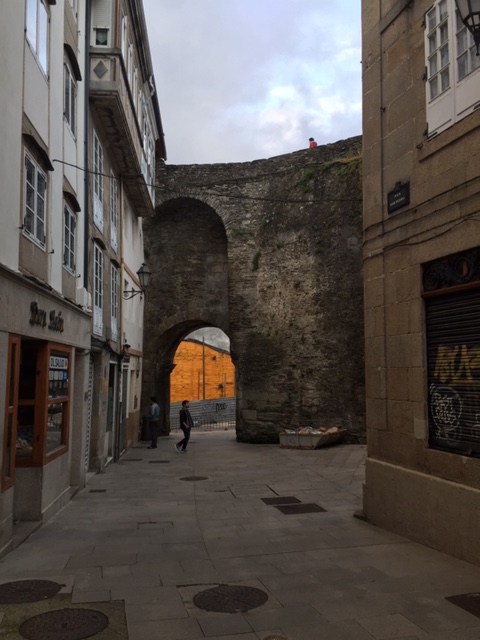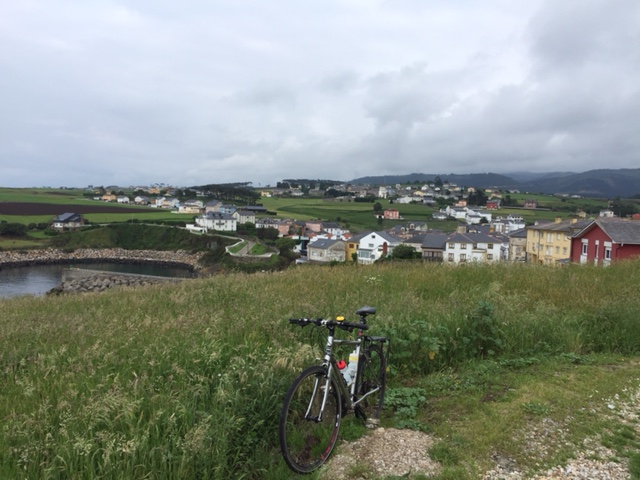Spain part 3
Galicia, Asturias, and the Basque Country; the limestone spires of Picos de Europa; Spain's infamous Atlantic coast on the Bay of Biscay; and the legendary Camino de Santiago de Compostela are in a region that had drawn me when I first made plans to cycle in Spain, but initially the south had won my first choice.
An advertisement for a flight from Malaga to Santiago for 49 Euro caught my attention & made me realize I should do both. The flight cost much more after I booked my bicycle. The scheduled arrival in Santiago was approaching 10pm. The flight was late, it was raining, and the shuttle to my hotel stopped running at 11, but everything worked smoothly and by midnight I was tucked into the most comfortable bed I had slept in for 2 weeks.
Still drizzling in the morning; breakfast was superb, but reception told me that they did not have a room for the next night. My next planned stop was 80 km east, my bike was still boxed in the garage, so it was time to move.

Immediately, I was passing clumps of walkers slogging along the last few Km of "El Camino" and I was glad to have a bike, and no fixed itinerary. I kept passing these souls on and off for the next 10 days, often in packs or groups strung out with 200 to 400 metres between them.

When I left their route I was immersed in fertile countryside. Rolling hills & valleys with clusters of slate-roofed farm houses. Small fields of crops or placid cattle, and oak trees - these were the gnarled, old common Oak like the UK, not the stocky "robles" under which feed the pigs in Castilla La Mancha and Andalucia.

There were main roads but by following routes that my offline mapping programme picked for "bike", I could keep in beautiful, quiet countryside. However, there were so many little roads that I was often cycling with the phone in one hand, or missing turns and re-tracing my path.
By Spanish law, cars must give 1.5 metres clearance to bicycles, and they would show impressive patience following me through villages where there was insufficient space to pass.

Also, my maps paid no attention to vertical relief, and my first sight of my destination (the city of Lugo which where the Romans mined gold) was from a lane 150 metres below its defences. To reach these I had to climb a 1:6 hill, then pass many dull, square blocks of apartment buildings.
Surprises are round every corner. With the bike & luggage transported by elevator to my Air-bnb in an upstairs flat, and safely bedded in the kitchen for the night, my host (who later offered to cook supper) and I walked round to his favourite bar where there was so much tapas (free bar food) that the supper became unnecessary. That was the night that Real Madrid met Liverpool for the Champions' League final so town was hopping. I walked round the Roman walls while he cooked, and we ate supper back in the apartment. It was a lovely evening.

I had thought of reaching Leon the next day until my host showed me pictures of significant snow beside the road and the map showed a pass over 1,200m. so I made an easy ride down to the Coast near Foz, past more pilgrims.
The next night, I had a Korean hostess who has a Spanish husband, two children, and a few acres of market gardens. She seemed to assume that I spoke no Spanish and I was happy to tour her garden (and taste the strawberries) with English instead.

TheCoast & beaches are lovely and there is a spectacular highway soring across valleys from Santander to Lugo, which keeps the traffic off the old road, but it and the smell of traffic were always present.


Next day I dived back inland to farming country designed more for 4 strong legs than for 2 wheels. I missed a turning early on, which must have been a tiny track and probably best missed. I discovered myself at a few hundred metres elevation, too far west, but in very picturesque hills. Best of all were the wild strawberries beside the road. Anyway, a little further and a rapid decent into the next valley brought me to Pravia, and an easy ride up river beside the railway to Grado for the night.

This narrow-gauge railway is a remarkable construction in itself. Many viaducts span the steep valleys west of Gijon (Xixon). Some, if not all of it was built in the late 1800's.

Gijon reminds me that town names and road signs are as politically significant as they can be in Western Canada. Place names are written twice (presumably Asturian and Castillian). These names are so similar that either spelling would be clear, but in a few cases supporters of one language or the other have tried to obliterate the spelling that they don't like. And don't confuse this with the Basque Country further east where the local language is not remotely similar.

Of course Almuerza (the mid-day meal) is the big meal of the day. Breakfast was often slim, and supper was mostly in tourist hotels. My routine became: earlyish start, lunch after a good ride, then a slower afternoon. This is one of 3 courses at a small village resteraunt.

I arranged more time in the North by booking a bus ticket from Oviedo to Madrid for 4th June (the day before my flight home to Calgary), and I wanted to confirm that the bus would take the bike. So I cycled from Grado through he city of Oviedo where I navigated busy 1-way streets to the bus station & confirmed that the ticket office would supply a big bag for Euro15 after which the bike could travel with me.
That left the afternoon to cycle 70 or 80 km to Cangas De Onis (Cangues d'Onis) outside Picos de Europa Park. Again, my maps lead me along to some steep farm tracks. Again it was pretty country, but the clouds would not lift to show any peaks. Cangas is a little tourist town centred around its famous Roman Bridge.


I booked a hotel, which was enormous and had a group of school kids to fill its echoing corridors that night. Spaniards can be effervescent and training for deafeningly loud conversation seems go start at school, but they were a friendly lot. Anyway, the receptionists were young, female, and keen to practice English so I relaxed.
Spaniards do not seem to start early in the mornings so I was on my own in the breakfast room when it opened at 7.30 and soon cycling up empty roads towards Covadonga, where a Christian Army turned back the Muslims in 700 and something AD. 10km further and 1km higher were the famous Lakes backed by mountain peaks, but I coldn't see more than 30 metres in the mist. However there was a stone hut selling hot coffee being patronized by a group of Portuguese back-packers.

One more adventure en route back to Oviedo for my bus: once more on tiny steep roads with a meadow sloping up on my left, and a parapit on the right, I found crowds of spectators and photographers, and the sound of loud engines reving behind me. Two men with radios waved me into a gate, then told me to cycle very fast for the next kilometre to get off the race course. Survived that!
Bus back to Madrid was well organized and punctual. All the public transport that I met in Spain was efficient and courteous. The bike ride across the city was mostly through parks reading maps with my phone in one hand again, and my landlady was waiting. She had saved the box for me to pack my bike for the flight, and insisted on getting up at 3.30am when I left by taxi for the airport - thank you Amelia!
Dave Hutchinson
Dave Hutchinson 587 228-3049